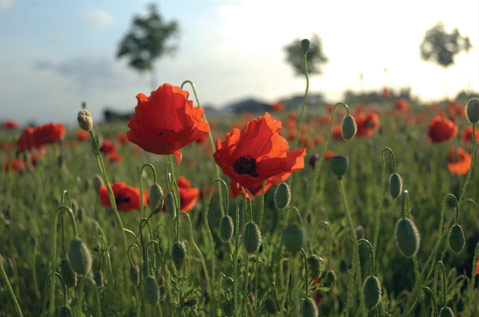Double Meanings
The Language of Plants

It’s all about communication, right? That childhood saying, “Sticks and stones may break my bones, but words can never hurt me” isn’t quite true (although it can be helpful in consoling a youngster now and then). Even within a language group, the meaning of a single word can vary wildly. In fact, context may be everything in some instances. Here are some words that mean something quite different in a uniquely horticultural situation.
Bed: Ahhh, that haven of comfort and sleep. But, no, it can also be the area of soil dedicated to growing certain plants.
Blanch: Gourmet cooks instruct a brief period of immersion in boiling water. Gardeners wrap their asparagus, cauliflower, and endive to exclude light so that they can no longer photosynthesize, but emerge pale and colorless.
Bolt: A metal fastener used universally in machines? Or the rush to flower that some annual plants, such as lettuce, may experience during a sudden heat wave.
Bud: Your bestie? Naw, it is the flower before it unfurls its petals and reproductive organs to the vagaries of pollination.
Cane: Yeah, Uncle Ernie uses one to get around, but in the garden, it is the semi-woody new growth of roses, berries, grapes, and others.
Crown: Fit for a royal leader, yes. Also, the aerial branching structure of trees (and lesser plants such as broccoli).
Deadhead: This one wasn’t ambiguous until Jerry Garcia and clan came to fame. For gardeners, it describes an essential task to encourage further flower production by removing the old ones.
Force: To do violence toward something or someone to accomplish one’s will. In the plant world, it means to treat them in some special way (manipulating light or temperature) to get them to produce beautiful flowers out of season.
Girdle: In the garden, it means to remove the cambium layer completely around a plant or (and this one more resembles the undergarment that is designed to compress the flesh) to tightly bind a plant and restrict the flow of nutrients causing stunting or death.
Lip: In humans (and other primates), that fleshy portal to the mouth. Flowers can have lips, too, but they usually serve as a landing platform for insect pollinators.
Spike: To hit the volleyball decisively over the net or thrust the basketball vigorously through the hoop. In the botanical world, it is the stem that holds multiple flowers as they emerge from the plant.
Spur: Cowboys relied on them to keep their horses motivated. Larkspurs and columbines have them as little extensions (usually filled with nectar) on one or more petals that look like the spurs on a rooster’s feet.
Standard: A level of performance or other measure of a set norm. A standard rose bush, or a citrus tree, however, is one that has been trained to have a straight trunk much higher than the norm that is topped by a pruned version of the original plant.
Thin: Normally an adjective that describes something that is slender. As a verb, it describes the reduction in numbers of fruit as they develop so that the remainder will be larger and more savory.
There are plenty more of these ambiguous words that require context to decipher. Learning English is not even easy for native-born speakers sometimes, and horticulturists have devised their own subset of the tongue.



